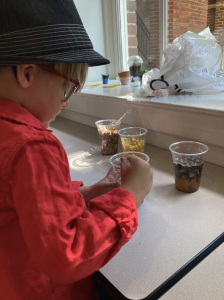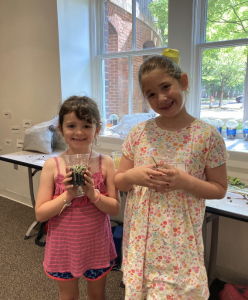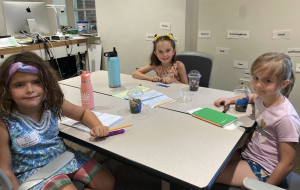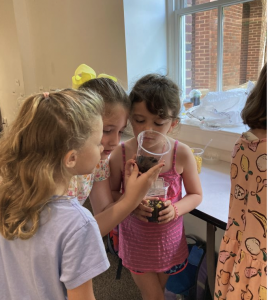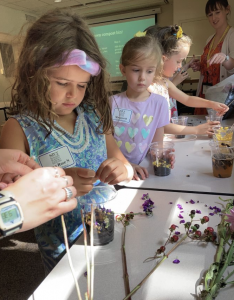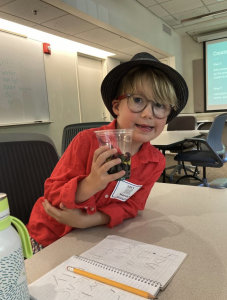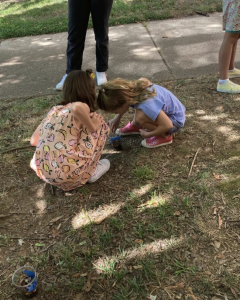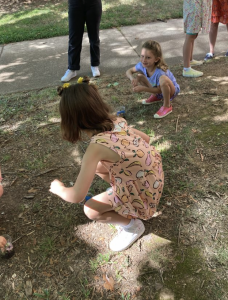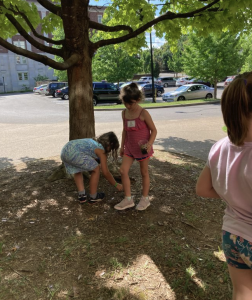Summer SAVY 2022/Session 3 – Becoming a Botanist for Rising 1st/2nd Grade
Posted by caughem on Monday, June 27, 2022 in blog, SAVY.
Friday: We had a great week of studying plants! This morning students learned about what happens to plants when they die. They learned that through the decomposition process, plants become soil that can provide nutrients to new plant life. Each child made a mini compost bin in a clear container, so they can watch the decomposition process at home. I provided compost to help speed up the process. They added the plant remains from previous experiments and collected dry leaves from the ground outside our classroom. After adding a little bit of water, they mixed the materials. It is best to keep the compost container in a sunny spot inside or outside. Water it if it looks dry.
As the final task of the problem-solving challenge, students worked in teams to design a building that meets the needs of the plant that can be used for vehicle fuel. They also used their imagination to create, categorize, and name the plant. Each group created a three-dimensional model of their greenhouse-like structure. They all had creative design ideas that benefitted the plants inside.
In addition to the mini compost bin, your child brought home the terrarium and their botany notebook today. They wrote directions for the experiments you can continue at home (the bean greenhouse and mini compost bin) in the notebook. These are some guiding questions you can ask to help your child explain the work in their notebook to you:
- How did you do an experiment to investigate what happens if a plant’s basic need(s) aren’t met?
- What changes did you notice over the course of the week with each plant in the experiment?
- What are the parts/elements of the terrarium?
- How is a terrarium a system? (they drew a diagram in the notebook)
- What changes occurred with the terrarium over the course of the week?
- What is the life cycle of a plant? How does a seed become a sprout?
- What are the parts of a plant?
- What do all plants have in common?
- How does compost help plants?
- What can be composted?(any plant matter)
- Why can’t plastic and Styrofoam be composted?
- Your child may enjoy writing down all the plants in your home or yard. Challenge them to group the plants into categories and explain the criteria they used to develop the categories. To extend this further, have them make sub-categories.
Thank you for the opportunity to share my passion for plants with your children! The class was enthusiastic and asked great questions to guide their scientific discoveries. I hope they take time to appreciate and learn from plants they see on your summer adventures!
Thursday: Today we took an in-depth look at what plants need to survive. We learned about how greenhouses allow plants to survive year-round in cooler climates. Students created the greenhouse in a bag that they brought home today. It will grow best if placed in a sunny window. The students started a log in their botany notebook. After our class ends, they will continue to monitor the beans and write/draw their observations in the notebook. When the beans begin to sprout, they can be planted in a pot or the ground. When they sprout, you may want to use a calendar to help your child figure out how many days it took for the seed to germinate.
New log entries from the problem-based learning scenario informed us that the research team found a plant that may be able to fuel cars on an island. Something about the plant cell is different. Unfortunately, the specimens collected are nowhere to be found. Students used what they know, plus their imagination, to draw a plant and plant cell that fit the description. Students looked at real plant cells using a microscope today! They made observations of the colors, patterns, and shapes. We learned what a cell wall is and noticed them on the slides.
The concept of photosynthesis was introduced today. Students collected small plant specimens outside. They examined their specimen using a magnifying glass. Students looked for the tiny holes (stomata) and veins that allow plants to take in carbon dioxide and water during the process of photosynthesis. When you take a nature walk or spend time in the yard, you can ask your child how specific plants get energy. You can also help them retain what they learned this week by asking them to explain the life cycle of specific plants. I look forward to our final day of learning together tomorrow!
Wednesday: This morning, students were introduced to a problem-based learning scenario about plants. A fictional professor is searching for a plant that can be used to power cars that doesn’t need to be combined with fossil fuels. Each day for the rest of this week, students will receive an entry from Professor Blackwell’s logbook. They will piece together information to determine the questions asked by the research team and interpret the information they gathered. They will consider how this information from the past can be used to solve future problems. As a part of this project, students synthesized their knowledge of systems to create a diagram of a car as a system.
We spent the rest of the day learning about seeds. The book Seeds Move! gave many examples of unique ways that seeds scatter, like the squirting cucumber! For the first seed investigation, students used a Venn Diagram to compare and contrast sunflower seeds and beans. These junior botanists are doing a great job collecting data and summarizing their research! They worked as a research team to study the parts of a seed. Each student dissected seeds and then we combined the research from each trial and used it to form conclusions. They found that the three seeds studied (corn kernel, pinto bean, and sunflower seed) all have seed coats. To continue this research, you can investigate seeds you eat or plant to determine if they also have seed coats. (It is helpful to soak seeds overnight before dissecting them.)
Tuesday: This morning I read students Tops and Bottoms and we discussed differences between how the vegetables grow. We did research to learn how each child’s favorite fruit grows. We used the example of a temperate forest to analyze the role of plants in an ecosystem. The book Be a Tree challenged students to think abstractly about how people are like trees. We discussed interactions in a forest (as a system) and compared them to interactions in a community.
We did a walking field trip of the arboretum on the Peabody campus. We read about specific trees on the iPad. Students sketched each tree on the tour in their Botany Notebook. We discussed similarities and differences in bark, leaves, and seeds pods. We even saw Tennessee’s state tree! You may want to ask your child which tree was their favorite and why.
This afternoon, students observed changes in their terrariums from Monday. They can tell you what happened since they created this system. The students did an experiment to investigate flowers. We asked questions about flowers and then used magnifying glasses (and the senses of smell, touch, and sight) to investigate cut flowers. Students pulled the petals off a flower to get an up-close look at the pistil. Some even found pollen in their flowers! These junior botanists are experts on many types of plants. Tomorrow we will take a closer look at seeds.
Monday: Welcome to Becoming a Botanist! Today we discussed our prior knowledge of plants and observed the plants outside our building. Students learned about the life cycle of a plant through picture books and asked thought-provoking questions about plants. I look forward to helping them find answers this week.
We also used the book Ada Twist, Scientist to talk about what a scientist does. Students learned that Botanists are scientists who study plants. Each student used their Botany Notebook to take notes on two experiments we set up today. The first is an experiment about the basic needs of plants. Students made hypotheses about what will happen to plants when a basic need is eliminated.
The second experiment gives students a concrete example of what a system is. They learned generalizations about systems (they have parts, boundaries, inputs, and outputs). Students each developed their own terrarium system. You may want to ask your child which part of the terrarium connects to each aspect of a system. Students will conduct observations on their terrariums daily and will bring them home on Friday. The week of learning about plants is off to a great start!
